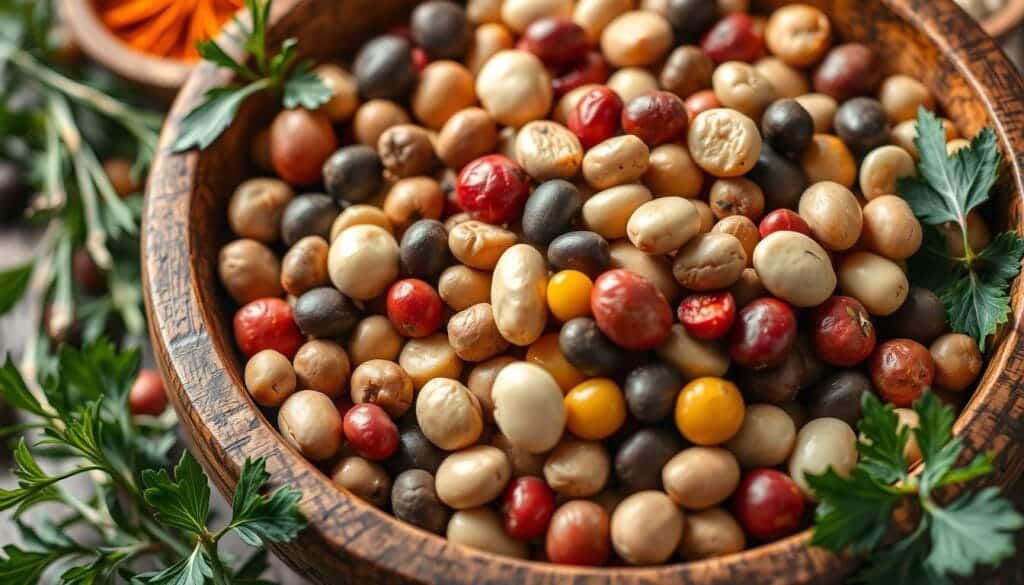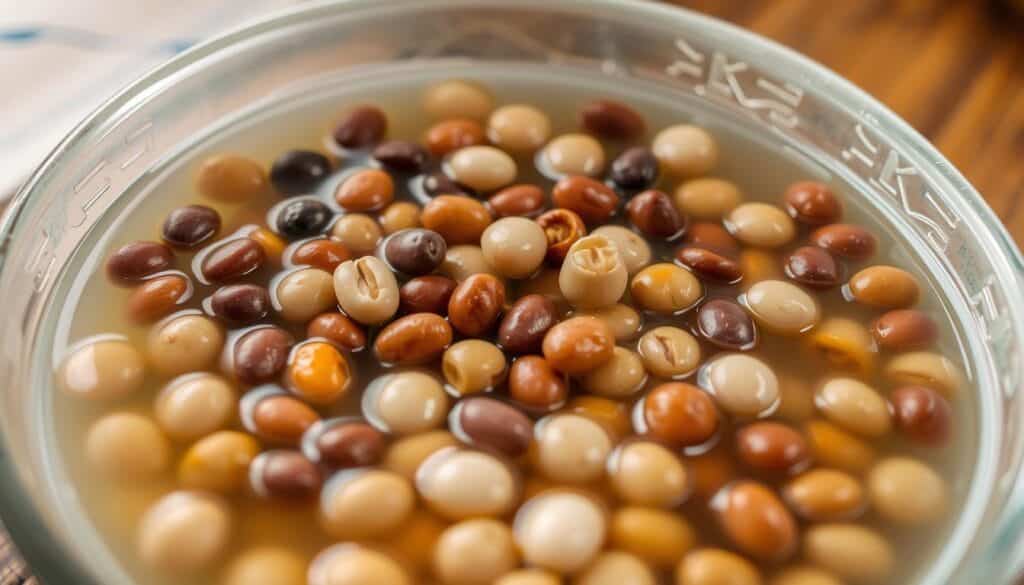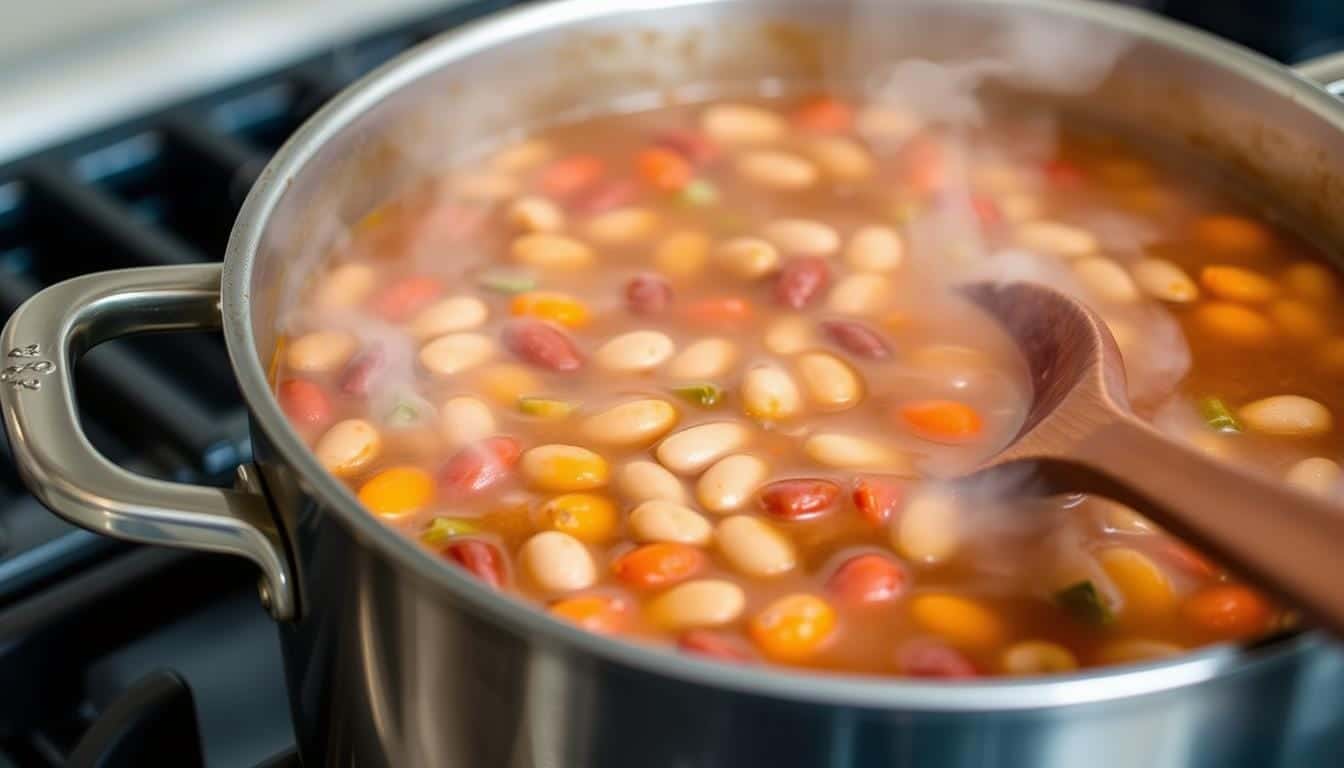How do you make 15 bean soup less gassy? Ever looked forward to a warm 15 bean soup, only to feel bloated afterwards? It’s common to face digestive issues after enjoying this nutritious dish. Learning how to make 15 bean soup less gassy is key for those who love it but hate the side effects.
Bean soups are full of protein, fiber, and nutrients. But they can also upset your stomach. Knowing how to cut down on gas in 15 bean soup can make cooking a joy, not a chore.
The trick is in how you prepare the beans. By using simple methods, you can make a bean soup that’s good for your gut. It won’t lose any of its delicious taste or nutritional value.
How do you make 15 bean soup less gassy

Bean soups are full of nutrients but can sometimes upset your stomach. When making your 15 bean soup, it’s key to know why you might feel gassy. This knowledge helps you enjoy your meal without discomfort.
What Causes Gassiness in Beans?
Beans have complex sugars called oligosaccharides that are hard for us to digest. These sugars go through your small intestine and then to your large intestine. There, gut bacteria start to break them down, making gas in the process.
- Oligosaccharides are difficult for human digestive systems to break down
- Gut bacteria ferment these undigested sugars
- Fermentation creates gas as a byproduct
The Role of Fiber in Digestion
Fiber is important for digestion and can help with bloating in bean soup. Even though it can cause gas at first, it’s good for your health. A 2022 Food and Health Survey found that 35% of Americans eat beans for their digestive benefits.
“Understanding your body’s response to beans can help you enjoy their nutritional benefits while minimizing digestive discomfort.”
By understanding how beans are digested, you can make bean soups that are tasty and easy on your stomach.
Preparing Your Beans for Cooking
Getting your beans ready is key to a better 15 bean soup. Soaking is a must to cut down on gas and make digestion easier.

Beans have sugars that are hard for our bodies to digest. Soaking breaks these down, making your soup easier to enjoy.
Why Soaking Matters
- Reduces cooking time
- Breaks down gas-causing compounds
- Improves bean texture
- Enhances nutrient absorption
Two Effective Soaking Methods
You can choose from two soaking methods:
- Overnight Soak:
- Soak beans for 8-12 hours
- Most traditional method
- Requires advanced planning
- Quick Soak Method:
- Boil beans for 2-3 minutes
- Let stand for 1 hour
- Perfect for last-minute meal prep
“Proper bean preparation is the secret to a delicious, gut-friendly soup.” – Culinary Nutrition Expert
Don’t forget to drain and rinse your soaked beans before cooking. This step can help reduce digestive issues and enhance your soup’s taste.
Using Flavorful Additions
Making a tasty 15 bean soup that’s easy on your stomach is simple. Choose herbs, spices, and aromatics wisely. This way, you can add flavor and cut down on gas.
Some ingredients can help with digestion in 15 bean soup. They not only make it taste better but also help it digest easier.
Digestive-Friendly Herbs and Spices
Want to know how to make 15 bean soup less gassy? Try these herbs:
- Fennel seeds: Known for reducing bloating and gas
- Cumin: Supports healthy digestion and adds warm flavor
- Thyme: Helps break down complex bean proteins
- Oregano: Natural carminative that reduces intestinal gas
Aromatics that Soothe the Stomach
Right aromatics can change your bean soup game. Ingredients like:
- Ginger root
- Garlic
- Fresh onions
“Cooking is about adding layers of flavor that not only taste good but make you feel good.” – Chef’s Wisdom
These aromatics are magic in breaking down sugars that cause stomach trouble. Your 15 bean soup will taste better and be easier to digest.
Cooking Techniques that Help
Cooking beans needs special techniques to cut down on gas and make the soup tasty and easy to digest. Knowing the best cooking methods can greatly reduce gas in your 15 bean soup.
The Power of Initial Boiling
Breaking down complex sugars is key to less gas in 15 bean soup. Boiling beans first helps break down oligosaccharides, which cause stomach trouble. Boil your beans hard for 10-15 minutes to start making them easier on your stomach.
- Boil beans vigorously for 10-15 minutes
- Drain initial cooking water
- Rinse beans before continuing cooking
Simmering: Finding the Perfect Cooking Time
Simmering is vital for less gas in bean soups. Cooking beans too long can make them fall apart, while not cooking them enough leaves sugars intact. Look for a gentle simmer that softens beans without making them mushy.
The key is finding the sweet spot between tender and overcooked.
Pressure Cooking: A Gas-Reducing Method
Pressure cooking is a top choice for less gas in 15 bean soup. The high heat and pressure break down oligosaccharides, making beans easier to digest. Most pressure cookers cut cooking time to 20-30 minutes, compared to old methods.
- Reduces cooking time
- Breaks down gas-producing sugars
- Preserves bean nutrients
Pro tip: Always follow manufacturer instructions when using a pressure cooker to ensure safe and effective bean preparation.
The Power of Acidic Ingredients
Reducing stomach discomfort in 15 bean soup is easier than you think. Acidic ingredients are key to making your soup more digestible and less bloating.
When making your bean soup, using acidic ingredients wisely can help. They make your soup easier to digest and reduce bloating. Let’s see how they work.
Why Tomatoes Help with Gassiness
Tomatoes do more than add flavor. They have natural acids that break down sugars in beans. This is why tomatoes are good:
- Breaks down difficult-to-digest sugars
- Adds rich flavor to your soup
- Provides additional nutritional value
Adding Vinegar or Lemon Juice
Acidic liquids like vinegar and lemon juice are great for reducing stomach discomfort. They work by:
- Softening bean fibers during cooking
- Helping to neutralize gas-producing compounds
- Enhancing overall digestibility
“A splash of acid can transform your bean soup from a digestive challenge to a comfortable, enjoyable meal.”
Try different acidic ingredients to find the right mix. This will help you enjoy your bean soup without discomfort.
Rinsing Beans: A Critical Step
Making a tasty 15 bean soup is more than just mixing ingredients. Rinsing beans is key to making the soup less gassy and easier to digest.
Soaking beans can lead to digestive issues. By draining and rinsing them well, you can cut down on gas-causing elements.
Why Draining Soak Water Matters
Soaking beans releases starches and sugars that cause gas. Draining this water removes these troublemakers before cooking.
- Discard the first soak water completely
- Rinse beans thoroughly under cold running water
- Use a colander for efficient draining
Effective Rinsing Techniques
To reduce gas in 15 bean soup, follow these rinsing steps:
- Drain initial soak water
- Rinse beans for 30-60 seconds
- Shake colander to remove excess water
- Repeat rinsing process 2-3 times
“Clean beans are happy beans!” – Culinary Wisdom
Pro tip: Cold water is better for removing gas-producing compounds than warm water.
Incorporating Digestive Aids
When making your 15 bean soup, adding natural digestive aids can help. Certain herbs and spices not only add flavor but also aid digestion.
Fennel Seeds: Nature’s Digestive Ally
Fennel seeds are great for fighting gas in 15 bean soup. These small seeds are full of compounds that aid digestion and prevent bloating.
- Helps reduce intestinal gas
- Supports smoother digestion
- Adds a subtle, sweet flavor to your soup
“A pinch of fennel seeds can transform your bean soup from uncomfortable to delightful.”
Ginger: A Soothing Addition
Ginger is another excellent choice for your 15 bean soup. It has anti-inflammatory properties that ease digestive discomfort and improve nutrient absorption.
- Calms the digestive system
- Reduces gas formation
- Provides a warming, zesty flavor
By adding fennel seeds and ginger, you make your bean soup more digestible and enjoyable. These natural ingredients help support your digestive health.
The Role of Broths and Stocks
Choosing the right broth can make your 15 bean soup amazing. The liquid you pick is key to reducing gas and improving taste and digestion.
Choosing Low-Sodium Broths Wisely
For your bean soup, choose low-sodium broths to cut down on bloating. Imagine Organic Low Sodium Free Range Chicken Broth is a great choice. It adds flavor without too much salt.
- Look for broths with 50% less sodium than regular versions
- Check sodium content per serving (aim for under 340 mg)
- Consider organic and low-sodium options
“The right broth can turn a simple bean soup into a digestive-friendly meal”
Flavor’s Impact on Digestion
Broths do more than just taste good. They can also ease digestive issues from beans. Making your own stock with herbs like fennel or ginger can boost digestion and flavor.
If you’re watching your budget, Campbell’s Unsalted Condensed Soups are a good, affordable choice. They can make your 15 bean soup even better.
Serving Tips for Better Digestion
Enjoying your 15 bean soup doesn’t have to mean suffering from gastrointestinal discomfort. Understanding how to serve and portion your meal can significantly help in reducing gastrointestinal discomfort in 15 bean soup.
Proper portion control plays a big role in easing gas from 15 bean soup. Your body needs time to adjust to high-fiber foods. So, start with smaller servings.
Pairing with Digestion-Friendly Foods
Strategically pairing your bean soup can make a big difference in digestive comfort. Consider these complementary food options:
- Probiotic-rich yogurt
- Fermented vegetables like sauerkraut
- Herb-infused side salads
- Ginger tea
“Small portions and smart pairings can transform your bean soup experience from uncomfortable to delightful.”
Portion Control: How Much is Too Much?
When it comes to bean soup, moderation is key. Start with a half-cup serving and gradually increase. This approach allows your digestive system to adapt and helps prevent excessive gas production.
- Week 1: 1/2 cup servings
- Week 2: 3/4 cup servings
- Week 3: Full cup servings
By following these serving tips, you can enjoy your delicious 15 bean soup while minimizing digestive discomfort.
Storing Leftovers: Best Practices
Proper storage is key when making 15 bean soup less gassy. Your leftover soup needs careful handling. This keeps its nutrients and reduces gas-causing compounds.
Refrigeration and Reheating Strategies
Follow these tips to store your bean soup right:
- Refrigerate leftovers within two hours of cooking
- Store in airtight containers
- Keep refrigerated for no more than 5 days
The Impact of Time on Gassiness
Bean soups change during storage, affecting digestibility. Fermentation processes continue even in the refrigerator, increasing gas-producing compounds.
Pro tip: Smaller portion sizes can help reduce digestive discomfort when reheating leftover bean soup.
Reheating Tips for Better Digestion
- Reheat soup to at least 165°F to kill bacteria
- Stir occasionally to distribute heat evenly
- Add a splash of water or broth to maintain moisture
If you can’t eat the soup in 5 days, freeze it. Frozen bean soup can last up to 3 months in freezer-safe containers.
Alternatives to Traditional 15 Bean Soup
Looking to cut down on gas in 15 bean soup? Try using different bean types. Mung beans are a great choice because they’re low in gas and packed with nutrients. A 2019 study in Nutrients found they’re easier on your stomach than other legumes.
Lentils and split peas are also good picks. They have fewer compounds that make you gassy. Soybeans and edamame are another smart choice. They’re full of protein and easier on your digestive system.
Want to make bean soup without the discomfort? Try adding a bit of baking soda while cooking. It helps break down gas-causing compounds. Or, cook beans under pressure or soak them overnight to cut down on gas.
Bean soup doesn’t have to be a digestive challenge. Choose low-gas beans and use clever cooking methods. This way, you can enjoy tasty, healthy soups that boost your health without the gas. Remember, all beans are good for you, providing fiber, protein, and important nutrients.
FAQ
Why do beans cause gas?
Beans have sugars like raffinose and stachyose that we can’t digest. These sugars get fermented by gut bacteria in the large intestine. This process leads to gas, bloating, and discomfort.
How long should I soak beans to reduce gassiness?
Soak beans for 8-12 hours, best overnight. Soaking breaks down sugars and reduces gas. Rinsing well after soaking can also help.
What herbs can help reduce gas in bean soup?
Fennel seeds, ginger, and cumin are great for digestion. They reduce gas, improve digestion, and flavor your soup. These herbs boost digestive enzymes and lessen inflammation.
Can I use a pressure cooker to make less gassy bean soup?
Yes, pressure cooking makes beans less gassy. High heat and pressure break down carbs better than regular cooking, making the soup easier to digest.
How does adding acidic ingredients help reduce gas?
Acidic ingredients like tomatoes and vinegar break down bean sugars. They also soften beans and make nutrients easier to digest.
Are there low-gas bean varieties?
Yes, some beans are less gassy. Black-eyed peas, lentils, and split peas are easier to digest than kidney or navy beans. They can reduce digestive discomfort.
How much bean soup should I eat to avoid digestive issues?
Start with 1/2 cup and gradually increase. This helps your body adjust to the fiber. Eating bean soup with probiotics can also aid digestion.
Can I freeze bean soup to reduce gassiness?
Freezing and reheating can make bean soup more digestible. Freezing breaks down some carbs, which may reduce gas when reheated.
What’s the best way to rinse beans?
Rinse beans under cold water in a colander. Discard the soaking water and rinse until the water is clear. This removes excess starch and gas-producing compounds.
Are canned beans less gassy?
Canned beans are often pre-cooked and less gassy. But they also have oligosaccharides. Rinsing canned beans well can help reduce gas and improve digestibility.
